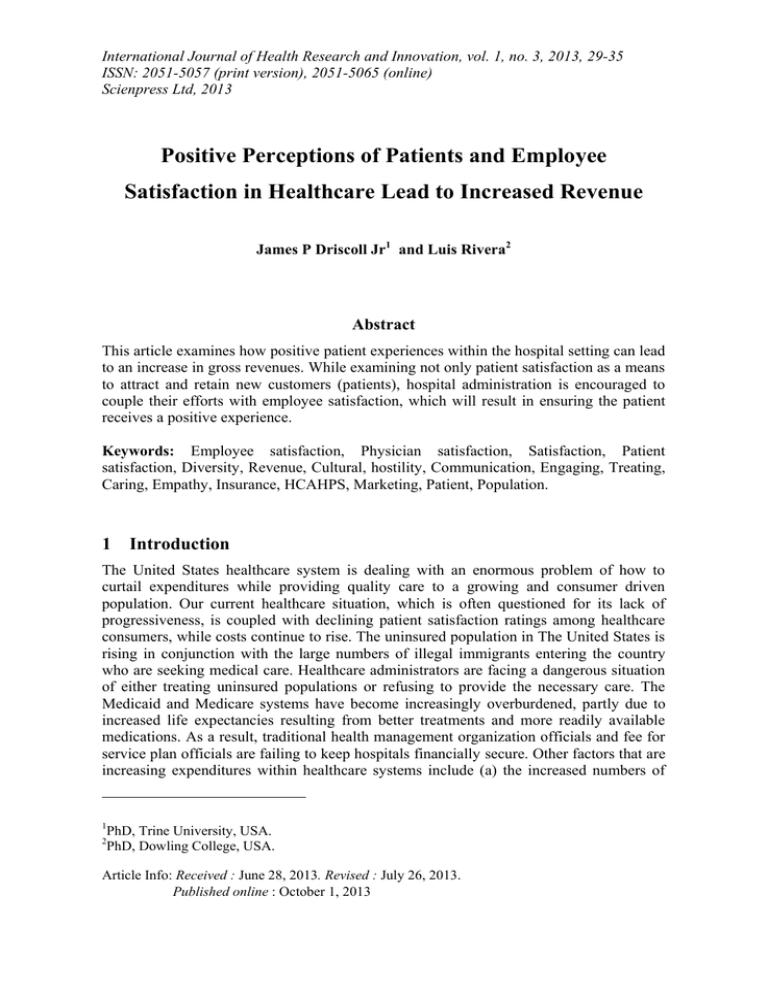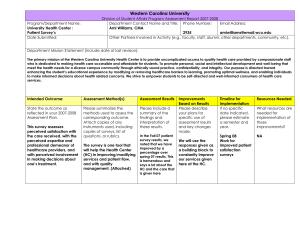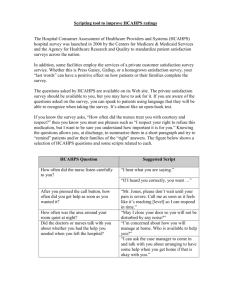Document 13732033
advertisement

International Journal of Health Research and Innovation, vol. 1, no. 3, 2013, 29-35 ISSN: 2051-5057 (print version), 2051-5065 (online) Scienpress Ltd, 2013 Positive Perceptions of Patients and Employee Satisfaction in Healthcare Lead to Increased Revenue James P Driscoll Jr1 and Luis Rivera2 Abstract This article examines how positive patient experiences within the hospital setting can lead to an increase in gross revenues. While examining not only patient satisfaction as a means to attract and retain new customers (patients), hospital administration is encouraged to couple their efforts with employee satisfaction, which will result in ensuring the patient receives a positive experience. Keywords: Employee satisfaction, Physician satisfaction, Satisfaction, Patient satisfaction, Diversity, Revenue, Cultural, hostility, Communication, Engaging, Treating, Caring, Empathy, Insurance, HCAHPS, Marketing, Patient, Population. 1 Introduction The United States healthcare system is dealing with an enormous problem of how to curtail expenditures while providing quality care to a growing and consumer driven population. Our current healthcare situation, which is often questioned for its lack of progressiveness, is coupled with declining patient satisfaction ratings among healthcare consumers, while costs continue to rise. The uninsured population in The United States is rising in conjunction with the large numbers of illegal immigrants entering the country who are seeking medical care. Healthcare administrators are facing a dangerous situation of either treating uninsured populations or refusing to provide the necessary care. The Medicaid and Medicare systems have become increasingly overburdened, partly due to increased life expectancies resulting from better treatments and more readily available medications. As a result, traditional health management organization officials and fee for service plan officials are failing to keep hospitals financially secure. Other factors that are increasing expenditures within healthcare systems include (a) the increased numbers of 1 2 PhD, Trine University, USA. PhD, Dowling College, USA. Article Info: Received : June 28, 2013. Revised : July 26, 2013. Published online : October 1, 2013 30 James P Driscoll Jr and Luis Rivera outpatient procedures being performed, (b) introduction of new prescription medications, (c) the increased use of current medications, (d) the changing demographics of the population due to longer life expectancy, (e) the increased the usage of a primary physician and medical specialists, and (f) the increase in federal and state mandates [20]. Ratajczak [17] estimated that by the year 2017 one third of the average household income would be spent on healthcare costs. The funding for this one third of income will come from co-payments, deductibles, taxes and reduced wage growth [17]. The officials at the American Hospital Association reported in a 1998 study that 29% of the nation’s hospitals are in some financial trouble, with total margins of 2% or less. In addition, these same officials also reported that Medicare payments would be dropping from 90 cents to 78 cents per dollar of care [21]. 2 Main Results 2.1 Patient Satisfaction In the hospital setting, nurses have a particularly important role. In 2008, the Centers for Medicare and Medicaid Services posted patient scores of "nursing quality" on its website; hospitals receiving significantly low scores will receive less Medicare reimbursement [13]. Performance is measured through patient surveys called the Hospital Consumer Assessment of Healthcare Providers and Systems (HCAHPS), which addresses quality issues from the patient perspective. Often hospitals will incorporate HCAHPS questions in a preexisting survey that is in place though an outside vendor. According to the federal government's Hospital Quality Initiative, "the intent of the HCAHPS initiative is to provide a standardized survey instrument and data collection methodology for measuring patients' perspectives on hospital care" [4]. With this type of methodology, hospitals are in essence being situated in a pay for performance model, but more importantly, the government has stepped into the arena to ensure healthcare is consistent across the country. Sample questions from the HCAHPS survey include the following [13]: • How often did nurses treat you with courtesy and respect? • How often did nurses listen carefully to you? • How often did nurses explain things in a way, you could understand? • After you pressed the call button, how often did you get help as soon as you wanted it? • How often was the area around your room quiet at night? • Before giving you any new medicine, how often did hospital staffs tell you about the medication? • Before giving you any new medicine, how often did hospital staff describes possible side effects in a way you could understand? In reviewing the HCAPS survey, 14 out of 22 patient experience questions focus partly or entirely on care provided by nurses [13]. Currently, participation in the HCAHPS survey is voluntary; hospitals have full ownership of their data from the HCAHPS survey, enabling them to analyze the information by their own metrics [4]. Today hospital administrators must compete in a market based on quality, price and product just as any business owners would who provide goods and services to the public [15]. More pressure is falling on healthcare providers to give better service with more options. This is partly due to patients paying more for their healthcare coverage; as a Positive Perceptions of Patients and Employee Satisfaction in Healthcare 31 result, patients are demanding more in return. Healthcare providers are aware of the situation especially the financial implications of not participating in HCAPHS, with a realization that cost consumer based effective, and efficient care is a necessity, not an option. Kurz and Wolinsky [12] and Heistand [8] found customers are relying less on doctors to select the right hospital. Reflecting on the importance of the patients’ point of view. It does not matter who is right or wrong. What matters is how the patient felt during their experience, even though the caregivers’ perception of their experience may be quite different. Often the patient’s perception is that the treatment from hospital staff is not reflective of the respect and dignity they deserve. If this is the case, hospital staff is actually performing a disservice to the patients, resulting in the patient not returning to the same institution for future healthcare needs. Hospital administrators have moved to a customer satisfaction focus, which has provided for another increase in hospital spending. More hospital administrators are offering special services that a decade ago was unthinkable. For example, the use of birthing suites has become a common facility in which many women give birth. The use of the birthing suite provides a pleasant atmosphere resembling a bedroom rather than a standard cold feeling delivery room. Many hospital administrators use the term customer more than ever to describe patients. Today hospital administrators realize that patients do have a choice in where they go for healthcare needs. Not addressing this, puts the hospital administrators at risk for losing revenue. Healthcare administrators are not alone in experiencing the rise in healthcare costs. Because patients are feeling the increase in their healthcare costs also, they expect more in terms of services from their healthcare providers. When hospital administrators need to reduce expenditures, this affects not only patients in the hospital but members of the community also feel the impact. 2.2 Advanced Access Another aspect focusing on making the patient experience better, while at the same time increasing efficiency is advanced access. Dr. Mark Murray and his partner Catherine Tantau pioneered advanced access in the early 1990s in their efforts to reduce wait times and increase patient satisfaction for Kaiser's Sacramento enrollees [7]. Advanced access is predicated on five basic principles [2]. Balance supply and demand. Do today's work today. Change the current steady state of appointment availability to a new and better steady state. Empower all providers and staff to function at their highest level of skill, education, experience, and credentials. Maximize efficiency. Although full implementation of advanced access takes a considerable amount of time to implement and realize its advantages, many physician-based practices have had success. Medical group practices have embraced the advanced access concept and experienced some or all of the following benefits [2]: • Increased patient satisfaction--Patient satisfaction is much higher when the patient is able to see his or her own physician at a time that is most convenient for the patient. Higher patient satisfaction will lead to greater patient retention and growth for the practice. • Process simplification--Simplifying processes will lead to higher staff satisfaction, less turnover, and better retention rates as well as decreased time spent on training and rework because of errors. 32 James P Driscoll Jr and Luis Rivera • Standardization of procedures--Standardized procedures that are well understood, consistent across the practice, and simple in nature reduce the chances for errors and increase the level of satisfaction for both staff and patients. • Increased staff morale--After the successful adoption of advanced access, the effect on the staff is universally positive, and an increase in staff morale and decrease in turnover will be seen. Direct savings are also realized in terms of recruitment, training, and retention costs. • Competitive market advantage--In this age of increased choice, medical group practices that have the capacity to offer immediate choices to patients have a competitive advantage. Furthermore, the groups' higher satisfaction rating with patients can result in more favorable contractual arrangements with payers. • Decreased stress--All the changes that occur as the group moves to advanced access will usually also lead to improved physician income and less stress in their personal lives. Employees also report having less stress in their day-to-day activities under this model. • Increased revenues--Through same-day scheduling, improved coding, growth in patient volume, and patient-to-physician continuity, the opportunity to capture additional revenues in a variety of ways exists for the practice. In addition, practices with capitation contracts gain the ability to handle a bigger panel of patients and command more dollars from the plans. The increased efficiency also means that these practices can grow without the expense of hiring additional physicians. A further, recent example of the link between patient satisfaction and service volume can be found at the University of Colorado Hospital (UCH), which launched an online system designed to streamline the arrival process by allowing patients to complete insurance paperwork, patient consent forms, and Health Insurance Portability and Accountability Act notification acknowledgments before visiting UCH. Patient satisfaction scores increased, helping boost outpatient visits in one year from 608,689 to 631,332 [3]. Satisfaction affects loyalty retention, which in turn increases revenues and lowers operating cost to increase profitability (Johnson, 1998; Reichheld, 1996). In support of this argument, research using national satisfaction indices in both Sweden and the US shows that satisfaction has significant positive impact on market value as well as accounting returns [1] [6] [10]. The healthcare arena is an industry in which customer satisfaction is critical to building a satisfied customer franchise; word of mouth recommendations are crucial [16] [18]. It has been estimated that the role of loyal patients is equal to two or three times their own value as customers based on word-of-mouth networking [14] [19] [23]. 2.3 The Culture Shift Woodside, Frey, and Daly [23] provided early evidence to support the premise that patient satisfaction may directly affect volume, and a quality culture has certain characteristics, which can be described as follows: • A quality culture, which is lively and progressive, can be found to be constantly evolving and helping to change the business. • A progressive quality culture within a business readily evaluates and responds to stimuli. • Like religious or political groups, business organizations also have the extreme quality culture, i.e. culture tries to preserve what is considered the true original set of beliefs. Positive Perceptions of Patients and Employee Satisfaction in Healthcare 33 • Large social migration sometimes creates hybrid quality cultures by the multinational companies. • Changes in quality culture of an organization occur when a leader provides stimulation with ideas that challenge tradition, e.g. Henry Ford, David Packard, and Walt Disney. • Behind all successful business, organizations there have been leaders who revived and changed the quality culture of their organizations. • In most cases, quality cultural changes are based on retaining and developing what is good in an existing quality culture and adding to it new total quality management principles that will stimulate organizational progress and create business excellence. The new elements, which will stimulate quality culture and create business excellence, are the basic principles of TQM. They include [11]: • Delight the customer • Continuous improvement • Management by fact • People-based management • Leadership Edvardsson, B., Johnson, M., Gustafsson, A., and Strandvik [5] were able to summarize the loyalty of customer service: “Yet this performance logic rests on some key assumptions, first, a firm’s customer base must have the opportunity to be loyal. Put differently loyalty is earned through high quality and satisfaction rather than being bought by, for example, a price promotion of other switching promotion. Two other assumptions further suggest that the satisfaction-performance logic is stronger for services. Customer referrals should have a greater impact on performance when the benefits of an offering are intangible and difficult to communicate in the market place. The logic also suggests that the impact of satisfaction on performance should be at least partially mediated by customer loyalty. Accordingly, satisfaction should have a direct effect on profits and growth as well as an indirect effect via loyalty”. When employees embrace the knowledge and power to perform their jobs, employee loyalty increases, which can lead to higher productivity, and in turn greater customer value. A mere 5% jump in customer loyalty can boost profits 25% - 85% [9]. 3 Conclusion In light of the increasing pressures on the administrators of healthcare organizations to cut costs, three factors can be used to judge their performance: change readiness, quality improvement and cost management [22]. Measuring quality in healthcare has taken on a new dimension as quality measures for clinical outcomes have now moved into the patient satisfaction realm. Clinical quality outcomes are important as in measuring the quality of care. Clinicians need to address issues that may arise from certain protocols and methods of treating patients. Using this crucial information allows the clinicians to determine better quality outcomes and to develop new treatment protocols. Although patients find satisfaction from their perception of and examination of clinical quality, they also use soft issues to develop satisfaction levels. Soft issues undergo scrutiny based on the patient’s experience and perceptions. Soft issues include, but are not being limited to: (a) being attentive to the emotional needs of the patient, (b) offering quality food, (c) offering amenities, and (d) the amount and type of compassion offered 34 James P Driscoll Jr and Luis Rivera by the staff. Responsiveness to customer needs is a relatively new topic of discussion for personnel in healthcare industry. As hospital facilities become overburdened with patients, and hospital administrators are burdened with financial constraints, maintaining staff responsiveness to patients can be a difficult target to meet and to measure References [1] [2] [3] [4] [5] [6] [7] [8] [9] [10] [11] [12] [13] [14] [15] [16] [17] [18] Anderson, E.W., Fornell, C., and Lehmann, D.R. Customer Satisfaction, Market Share, and profitability: Findings from Sweden. Journal of Marketing, 1994, 58, 53-66 Boelke, C., B. Boushon., and Isensee. Achieving Open Access: The Road to Improved Service and Satisfaction. Medical Group Management Journal 2000, 47(5) 58-62, 64-66, 68. Burt, T. Reinventing the Patient Experience. Healthcare Executive, 2006, 21(3) 8-14. Coombs, J. B., J. Hereford., and P. C. LePore. The CAHPS Hospital Survey: Fact Sheet. Centers for Medicare and Medicaid Services (CMS). Online information retrieved: 08/1/09.fw.cms.hhs.gov/HospitalQualitylnits/downloads/Hospital-HCAHPSFactShe et200709.pdf Edvardsson, B., Johnson, M., Gustafsson, A., and Strandvik, T. The Effects of Satisfaction and Loyalty on Profits and Growth: Products versus Services. Total Quality Management, 2000, 11(7), S917-S927 Fornell, C. A National Customer Satisfaction Barometer: The Swedish Experience. Journal of Marketing, 1992, 52, 31-46 Gill, Jag. A non-financial approach to financial improvement of medical groups through advanced access. Journal of Healthcare Management 2004, 7-8 Heistand, M. NY hospitals treat marketing-ills? Adweek, 1986, 27(27), 2. Heskett J.L., Jones T.O., Loveman G. W., Sasser Jr W.E., Schlesinger L. A. Putting the Service-Profit Cain to Work. Harvard Business Review, 1994, 3(4), 164 - 174 Ittner, C.D., and Larcker, D.F. Measuring the Impact of Quality Initiative on Firm Financial Performance. Advances in the Management of Organizational Quality, 1996, 1-37 Kanji, Gopal K., Wallace, William. Business excellence through customer satisfaction. Total Quality Management, 2000, (11), 7 Kurz, R.S., & Wolinsky, F.D. Who picks the hospital: practitioner or patient? Hospital and Health Services Administration, 1985, 30(March/April), 95-106. Lutz, S. L., and D. Root. Nurses, Consumer Satisfaction, and Pay for Performance. Healthcare Financial Management, 2007, 61(10), 57-63. MacStravic, S. Patient loyalty to physicians. Journal of Healthcare Marketing, 1995, 14(4), 53-58. Panko, R. The healthcare game: Cutting costs but not quality. Bests Review, 1996, 97(4), 32-38. Plymire, J. Complaints as opportunities. Journal of Consumer Marketing, 1991, 8(2), 9-43. Positive Perceptions of Patients and Employee Satisfaction in Healthcare 35 [19] Ratajczak, . On the measure of healthcare. Journal of the American Society of CLU & ChFC, 1997, 51(5), 22-24. [20] Reicheld, F., & Sasser Jr., W. Zero defections: Quality comes to services. [21] Harvard Business Review, 1990, 86(5), 105. [22] Rubin, H.R., & Gandek, B., & Rogers, W.H. Patient’s ratings of outpatient visits in different practice settings. Journal of the American Medical Association, 1993, 270, 835-40. [23] Rising medical costs and utilization drive premium increases and constrict [24] Margins. Healthcare Strategic Management, 1998, 16(5), 9. [25] U.S.’s hospitals control costs while experiencing variable profitability. Healthcare Strategic Management, 1999, 17(3), 7-8. [26] West, T. Comparing change readiness quality improvement and cost management among veterans administration for profit and non-profit hospitals. Journal of Healthcare Finance, 1998, 25(1), 46-58. [27] Woodside, A. G., L. L. Frey., and R. T. Daly. Linking Service Quality, Customer Satisfaction, and Behavioral Intention. Journal of Health Care Marketing 1989, 9(4), 5-17.Z. Bodie, A. Kane and A.J.Marcus, Investments, Seventh edition, McGrawHill, New York, 2008.





